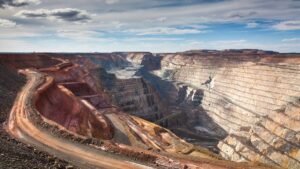Zero to Hero: The ‘tired’ gold mine that transformed Bellevue from shell company to $650m market darling

Pic: Tyler Stableford / Stone via Getty Images
When Bellevue (ASX:BGL) picked up its namesake historic mine in 2016 the explorer mentioned that major miner Barrick had offloaded it years earlier “due to no ‘Barrick sized’ targets”.
It turns out Barrick was probably wrong. Since January 2017, Belllevue’s share price has rocketed from 2.5c to +95c per share – driven by some unbelievable success at this historic WA project.
Bellevue has now defined 2.2 million ounces (moz) grading 11.3 grams per tonne (g/t) gold— making it one of the fastest and highest-grade gold discoveries in the world.
This gold was “hidden in plain sight”, adjacent to the historic gold workings which produced 800,000oz between 1897 and 1997. And that’s just the beginning because high-grade gold mineralisation remains ‘open’ everywhere.
2021 will be the year of development, managing director Steve Parsons says – an incredible achievement in such a short amount of time.
But first, a recent history of this remarkable project.
In 1997, the Kerry Harmanis explorer Jubilee Mines was celebrating a massive, high-grade nickel discovery about 500m east of Bellevue.
This discovery, called Cosmos, occurred just as the Bellevue mine looked to be mined out. Meanwhile, a big Aussie gold company called Plutonic came in and bought the Bellevue mine.
“Their view was ‘let’s see if we can find the extension of Bellevue — it couldn’t just disappear’,” Parsons told Stockhead.
“But as they were dialling in on some targets at Bellevue, Plutonic were taken over by US company Homestake – not because of Bellevue, but because the Darlot discovery to the south was turning into this big 5moz, high-grade orebody.
“From that point no work got done on Bellevue.
“Plutonic had come up with these really good concepts which were never tested because they got taken over.”
Then six months later in 2001 gold major Barrick acquired Homestake. They wouldn’t have even known that Bellevue existed in their portfolio.
“At that point, they divested all assets they thought were of little value, of which Bellevue was one,” Parsons says.
They sold it to Harmanis, who had no intention of exploring for gold.
“All he did was dewater his nickel workings at Cosmos into the old gold workings at Bellevue,” Parsons says.
“Just think — if Plutonic wasn’t taken over, they would have discovered the rest of the ore and Bellevue would still be an operation 20 years later, just like Jundee and St Ives.”
From humble beginnings
In 2016, Bellevue was a tiny shell company called Draig Resources. The company had been involved in a number of failed ventures over its listed life, including a sunglasses business and a coal asset in Mongolia.
Chairman Ray Shorrocks, who had been with the company for a number of years, was looking for an asset.
Specifically, a brownfield (previously explored or mined) gold asset in Western Australia. His view was that brownfields meant there was a better chance of finding something.
In August that year Draig acquired Bellevue, a project that was very much viewed as ‘old and tired’.
Shorrocks didn’t have a technical team. He had heard of geologist Steve Parsons, who founded Gryphon Minerals and built it into a +3moz ASX200 gold company before selling it off.
Shorrocks approached Parsons and his team to take a look at a proverbial mountain of Bellevue mining and exploration data. Parsons says he quickly realised the opportunity.
“The Bellevue gold mine had historically produced almost 1 million ounces at 15g/t, but no one had drilled one hole into it for 21 years,” he says.
“You have to remember that Plutonic spent a lot of time building up the target, but never got around to drilling it.
“With new theories and new technology, we backed ourselves to find the extensions to this high-grade lode.”
There were plenty of non-believers. It wasn’t just that no one had looked for the Bellevue extensions – the prevalent view was that there was nothing to be found.
In March 2017, Parsons was tapped to lead the company as exec director.
“At that point we were taking our time to make sure we got it right,” he says.
“Our guys took control of the company in March/April 2017 and it was a whole six months before we drilled it.
“All up, that was 12 months of nothing happening on the project.”
That’s a pretty rare approach for exploration companies. For cash strapped exploration plays, getting some nice early drilling results helps to build some share price momentum, Parsons says.
“However, our take on it was ‘don’t waste money; let’s get the geology right. When we are right on the geology then let’s go and drill a hole’,” he says.
At that point the 2.5c-per-share minnow had barely any traction with the market, except with a guy called Tolga Kumova, who came on board as a key investor when Parsons first got involved.
Kumova’s past investments included graphite play Syrah Resources (ASX:SYR), which he took from a penny stock to ASX200 high flyer between 2014 and 2016.
“Tolga was really just backing me and a couple of the other guys that were involved,” Parsons says.
“His view was simply ‘let’s see if there’s something there’.”
‘Highway’ to the Danger Zone
It wasn’t until Q4 2017 that Bellevue drilled those company making first holes.
As part of that maiden program Bellevue wanted to drill a couple of holes on the other side of a ‘fault’, called Highway, in an area considered moose pasture.
“Everyone was telling us we wouldn’t find anything,” Parsons says.
“But it was one of those first two holes, drilled on the other side of that fault, that hit 7m at 27g/t.
“We knew we were onto something immediately. That hole was such a massive step out, in a brand-new area that had never been tested before – we just knew.”

The share price went very quickly from 3c, to 5c, to 10c, and then briefly popped to about 30c before coming back down to 20c.
Bellevue became a $100m market cap company on the back of those initial two drill holes.
“The market very quickly understood the significance of having two drill holes, 100m apart, on a brand-new structure that had never been drilled before,” Parsons says.
“Right next door to one of Australia’s best gold mines.”
The rest is history.

Who will be the ‘next Bellevue’?
Bellevue’s ongoing success, along with the high gold price, has prompted countless explorers to revisit very old, often high-grade mines in Australia and overseas.
“I would like to think there are plenty of opportunities for other companies,” Parsons says.
“Those unafraid to stop and think about the geology in a new way, then punt a few holes and give it a real go.
“There are plenty of old deposits that people have given up on. The thought might’ve been something like ‘all the mineralisation is in the sediments, don’t bother looking across into the basalts’, or something like that.”
But geological thought evolves, Parson says.
“Everyone was saying we wouldn’t find anything on the other side of the Highway fault, for instance,” he says.
“And they were completely wrong.
“There will be several more companies making Bellevue type discoveries, without a doubt.”
Related Topics

UNLOCK INSIGHTS
Discover the untold stories of emerging ASX stocks.
Daily news and expert analysis, it's free to subscribe.
By proceeding, you confirm you understand that we handle personal information in accordance with our Privacy Policy.








